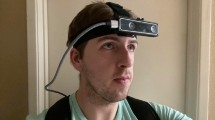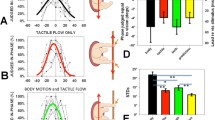Abstract
Vestibular research on human perception of self-motion and orientation generally uses the head-based coordinate system standardized by Hixson, Niven, and Correia (1966) for specifying accelerations of the subject. This paper expands the head-based system to include velocities, thereby incorporating both the visual and vestibular systems, and formally defines the resulting concept of asubject-coincident coordinate system. By capturing the organism's vantage point during self-motion, subject-coincident systems give a natural framework for studying the relationship between stimulus, physiology, and perception; however, the essential approach differs from that familiar in traditional physics, so the necessary equations of motion are developed here. In addition, these equations are used to investigate the set ofsustained motions, those motions that can be sustained over a period of time. These motions can cause disorientation and misperception of motion because of saturation or adaptation of the human sensory receptors. The results on sustained motions are summarized in a complete categorization of the set of sustained motions.
Similar content being viewed by others
References
Borah, J., Young, L. R., and Curry, R. E. (1988). Optimal estimator model for human spatial orientation,Annals of the New York Academy of Sciences,545, 51–73.
Britting, K. R. (1971).Inertial Navigation Systems Analysis, Wiley, New York.
Cohen, M. M., Crosbie, R. J., and Blackburn, L. H. (1973). Disorienting effects of aircraft catapult launchings,Aerospace Medicine,44, 37–39.
Dichgans, J., and Brandt, Th. (1978). Visual-vestibular interaction: Effects on self-motion perception and postural control, inHandbook of Sensory Physiology, Vol. 8, R. Held, H. W. Leibowitz, and H. L. Teuber, Springer-Verlag, Berlin, pp. 755–804.
Etkin, B. (1959).Dynamics of Flight, Wiley, New York.
Goldstein, H. (1980).Classical Mechanics, Addison-Wesley, Reading, Massachusetts.
Guedry, F. E. (1974). Psychophysics of vestibular sensation, inHandbook of Sensory Physiology, Vol. 6, H. H. Kornhuber, ed., Springer-Verlag, Berlin, pp. 3–154.
Guedry, F. E. (1992). Perception of motion and position relative to the earth,Annals of the New York Academy of Sciences,656, 315–328.
Guedry, F. E., Rupert, A. H., McGrath, B. J., and Oman, C. M. (1992). The dynamics of spatial orientation during complex and changing linear and angular acceleration,Journal of Vestibular Research,2, 259–283.
Hixson, W. C., Niven, J. I., and Correia, M. J. (1966).Kinematics Nomenclature for Physiological Accelerations, Naval Aerospace Medical Institute, Pensacola, Florida.
Holly, J. E., and McCollum, G. (1995). The shape of self-motion perception—I. Equivalence classification for sustained motions,Neuroscience, to appear.
Kandel, E. R., Schwarz, J. H., and Jessel, T. M. (1991).Principles of Neural Science, Elsevier, Amsterdam.
Peters, R. A. (1969). Dynamics of the vestibular system and their relation to motion perception, spatial disorientation, and illusions, NASA CR-1309.
Author information
Authors and Affiliations
Rights and permissions
About this article
Cite this article
Holly, J.E. Subject-coincident coordinate systems and sustained motions. Int J Theor Phys 35, 445–473 (1996). https://doi.org/10.1007/BF02083826
Received:
Issue Date:
DOI: https://doi.org/10.1007/BF02083826




